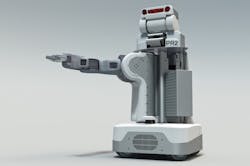After getting its start in the space program in the 1950s, computer vision technology slowly but steadily worked its way into numerous industrial and commercial applications. According to Jeff Bier, founder of the Embedded Vision Alliance, factory automation has been the most successful application for computer vision. The vision system industry surrounding factory automation is now a multi-billion dollar a year industry, built on the sales of systems costing anywhere from tens of thousands to hundreds of thousand of dollars.
“But what if you could get a computer vision system for about $100?” Bier asks. “You could essentially create a ‘throw-away’ vision system for a manufacturing application.”
Underscoring his point about inexpensive vision systems, Bier points to now commonplace products such as LiveScribe and Kinect—which each retail for about $200 or less. “Vision systems are getting cheaper and smaller and operate with much lower power requirements and thus can be deployed in ways that were previously impossible for vision systems,” he says.
Bier acknowledges that these low-cost vision systems are not as capable as the more costly systems, “but their limitations can often be worked around” through the use of algorithms or the deployment of an array of multiple low-cost vision systems.
As a case in point that this can be done and is, in fact, already being done, Bier told me about his experience with Willow Garage, a California-based developer of robots and robotic platforms and software. When Bier first met with the company, Willow Garage was using high-end vision systems to serve as the eyes of their robots. On a more recent visit, he saw that the developer had started using Kinect systems for robot vision.
“The developers at Willow Garage readily admit that Kinect is not as good as the more expensive vision systems they used previously. However, the developers have been able to compensate for the difference with algorithms and have experienced significant savings using Kinect as part of their robot systems.
As with Willow Garage, Bier says we should “expect to see innovative manufacturers adopt some of these new computer vision technologies to put vision in places where it has never been before. We’re going to see disruptions in how computer vision is used across industries with these cheaper systems. It's both an opportunity and a threat for manufacturers.”
To put in perspective the impact low-cost computer vision systems like Kinect have already had on the industry, Bier points out that Kinect has generated about $1 billion in revenue for Microsoft, which is considerable when you take into account that revenues for the entire computer vision industry is just a few billion dollars a year.
“The success of Kinect proved that there are applications for computer vision technologies outside of manufacturing,” Bier says, “ and this has started a step function in investment—a landgrab mentality in computer vision. For example, at the Consumer Electronics Show this year I saw eight low-cost sensor companies, none of which would probably exist without Kinect. In turn, this is all accelerating innovation in design systems that can be used to create and run vision systems, such as National Instruments’ LabView, as well as at companies that develop other components used in vision systems such as sensors, processors, etc.”
This step function in investment has also helped grow Bier’s Embedded Vision Alliance, which was formed just two years ago to “inspire and empower embedded system designers to use embedded vision technology … by providing them with the practical know-how they need in order to effectively incorporate embedded vision technology into their designs.” The alliance launched with just 16 member companies but now has 33.
“Engineers need to be aware of the economics impacting vision applications,” Bier says, noting that low-cost computer vision is in much the same place that wireless networking in manufacturing was just a few years ago, i.e., not many engineers know much about it.
Looking forward, Bier says that automotive safety appears to be the next “big opportunity” for computer vision. Mercedes and Volvo were among the first to introduce use of the technology for collision avoidance. But the technology is coming down squarely into midmarket with Subaru’s deployment of its Eyesight driver assist technology. Eyesight includes adaptive cruise control, lane departure warning and collision mitigation. See a video below from Subaru that explains the Eyesight technology.
“Factory automation showed that computer vision can be robust but expensive; automotive safety applications are showing that computer vision can be robust and inexpensive,” Bier says.
To learn more about the Embedded Vision Systems Alliance and its Embedded Vision Summit, held in Boston and San Jose, visit: www.embedded-vision.com
The video below explains Subaru’s Eyesight technology.


